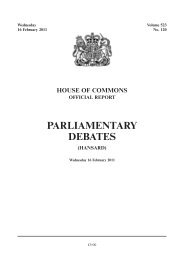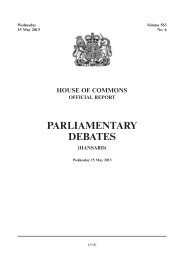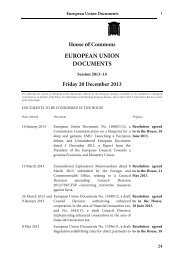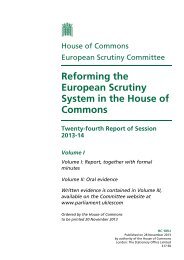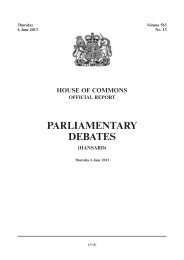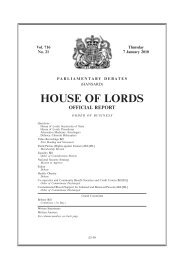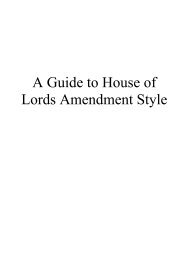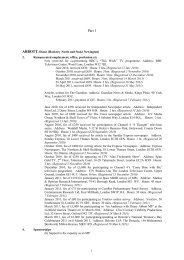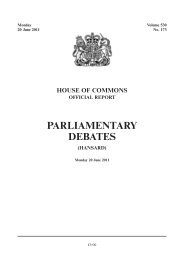Ticketing and Concessionary Travel on Public Transport - United ...
Ticketing and Concessionary Travel on Public Transport - United ...
Ticketing and Concessionary Travel on Public Transport - United ...
Create successful ePaper yourself
Turn your PDF publications into a flip-book with our unique Google optimized e-Paper software.
Ev 112 <strong>Transport</strong> Committee: Evidence<br />
Generati<strong>on</strong> of Passengers<br />
TRL publish a document, The dem<str<strong>on</strong>g>and</str<strong>on</strong>g> for public transport: a practical guide that is the “bible” for<br />
elasticities. Chapter 6 deals with fare elasticity. It shows that fares elasticity is higher for oV peak <str<strong>on</strong>g>and</str<strong>on</strong>g> leisure<br />
use. There is a l<strong>on</strong>g-term eVect that is larger than the “short run” elasticity. Table 6.55 pulls together the<br />
findings from many studies <str<strong>on</strong>g>and</str<strong>on</strong>g> for “Suburban rail—UK—oV-peak—short run” quotes a mean across<br />
studies of –0.79. This means that a 100% fare reducti<strong>on</strong> (free fares) would generate 79% more passengers.<br />
Applying this to the 18k c<strong>on</strong>cessi<strong>on</strong> passengers <strong>on</strong> TVL means that (0.79x18k) 14.2k extra c<strong>on</strong>cessi<strong>on</strong><br />
passengers would use TVL. This amounts to (14.2/111) 12.8% extra passengers over the whole passenger<br />
base of 111k. The CRDS has a target to reduce subsidy per passenger by 50%, increasing the denominator<br />
in that equati<strong>on</strong> by 12.8% will reduce the target by 11.3%, a worthwhile c<strong>on</strong>tributi<strong>on</strong> towards the 50% target.<br />
This is based <strong>on</strong> a “short run” elasticity <str<strong>on</strong>g>and</str<strong>on</strong>g> will produce more eVect in the l<strong>on</strong>g term.<br />
APPENDIX 8<br />
COMPARISON OF TRAIN AND BUS JOURNEYS FROM SETTLEMENTS ON RAIL LINES<br />
OTHER THAN CRs<br />
Source. <str<strong>on</strong>g>Travel</str<strong>on</strong>g>ine for 28 February 2007 post-0930 journeys checked <strong>on</strong> 27 February.<br />
Appendix 1 made the same comparis<strong>on</strong>s from a stati<strong>on</strong>s/settlements <strong>on</strong> a branch line that was designated<br />
CR. Small stati<strong>on</strong>s <strong>on</strong> mainlines (that cannot be CR designated) often oVer a vital public transport link to<br />
larger towns/cities <str<strong>on</strong>g>and</str<strong>on</strong>g> some of those are menti<strong>on</strong>ed below. As with TVL the train is often a far better <str<strong>on</strong>g>and</str<strong>on</strong>g><br />
sometimes the <strong>on</strong>ly reas<strong>on</strong>able alternative. There is a “double whammy” eVect at Whimple <str<strong>on</strong>g>and</str<strong>on</strong>g> Lostwithiel,<br />
where bus services to the destinati<strong>on</strong>s menti<strong>on</strong>ed have been requested from the local authority but they have<br />
declined to subsidise such services as a train alternative exists.<br />
Av<strong>on</strong>cliV to Bath<br />
Hourly train to Bath taking 15 minutes. Original settlement <str<strong>on</strong>g>and</str<strong>on</strong>g> railway stati<strong>on</strong> in valley bottom. Steep<br />
hills <str<strong>on</strong>g>and</str<strong>on</strong>g> narrow lanes to newer part of settlement. Only upper part of Av<strong>on</strong>cliV served by bus. Half-mile<br />
steep uphill walk from Old Peoples Apartments to bus stop. Bus every two hours <str<strong>on</strong>g>and</str<strong>on</strong>g> takes 30 minutes to<br />
Bath.<br />
Dunbridge (Stati<strong>on</strong> now renamed Mottisf<strong>on</strong>t <str<strong>on</strong>g>and</str<strong>on</strong>g> Dunbridge) to Romsey<br />
Trains at 1200 <str<strong>on</strong>g>and</str<strong>on</strong>g> 1300 taking six minutes to Romsey, with three return opti<strong>on</strong>s. A bus at 0919 (before<br />
0930), then no bus till 1553 without a same day return.<br />
St Germans to Plymouth <str<strong>on</strong>g>and</str<strong>on</strong>g> Liskeard<br />
Train journey to Plymouth takes 18 minutes. One bus opti<strong>on</strong> to Plymouth is possible with a change of<br />
bus <str<strong>on</strong>g>and</str<strong>on</strong>g> takes 75 minutes but there is no same day return bus. In the Liskeard directi<strong>on</strong> the train journey<br />
takes 12 minutes. There is <strong>on</strong>e bus opti<strong>on</strong> to Liskeard taking 65 minutes with a change of bus but no same<br />
day return by bus.<br />
Kemble to Swind<strong>on</strong> <str<strong>on</strong>g>and</str<strong>on</strong>g> Gloucester<br />
Hourly train to Swind<strong>on</strong> (16 minutes) <str<strong>on</strong>g>and</str<strong>on</strong>g> Gloucester (35 minutes). Two changes of bus in both directi<strong>on</strong>s<br />
to both destinati<strong>on</strong>s are needed. The <strong>on</strong>ly eVective return bus trip to Swind<strong>on</strong> would need 284 minutes (32<br />
by rail) for a 79-minute stay. The <strong>on</strong>ly eVective return bus trip to Gloucester takes 258 minutes (70 by train)<br />
<str<strong>on</strong>g>and</str<strong>on</strong>g> yields 105 minutes in Gloucester.<br />
Whimple to Axminster <str<strong>on</strong>g>and</str<strong>on</strong>g> Exeter<br />
Train service two-hourly with some additi<strong>on</strong>al trains. 22 minutes to Axminster <str<strong>on</strong>g>and</str<strong>on</strong>g> 16 to Exeter Central.<br />
Only eVective return by bus to Axminster takes 269 minutes (44 by train) with <strong>on</strong>e change of bus for a 98minute<br />
stay. To Exeter there are two eVective returns by bus, both with <strong>on</strong>e change each way. They take<br />
198 or 176 minutes (32 by train).



